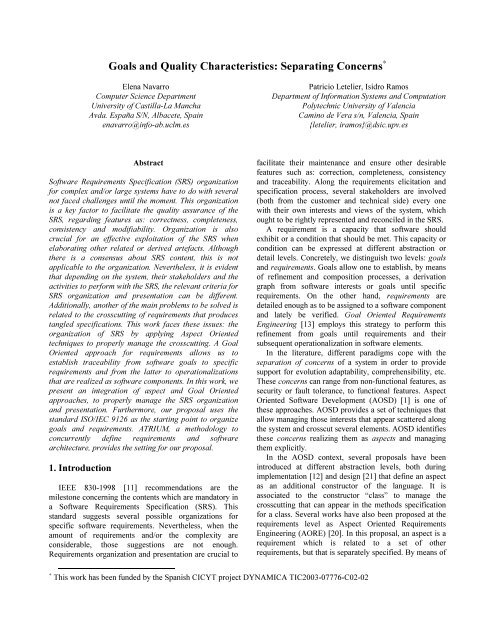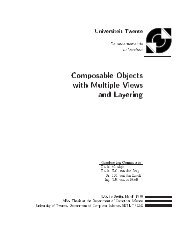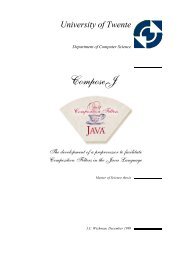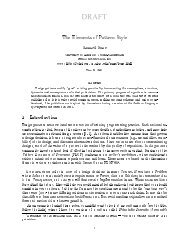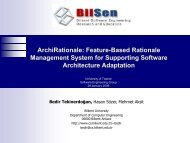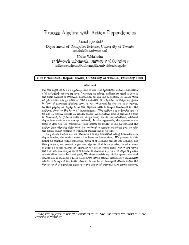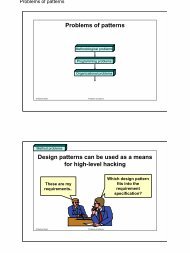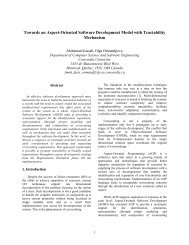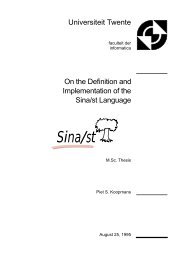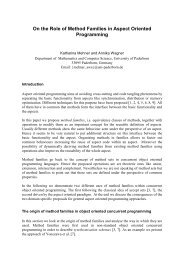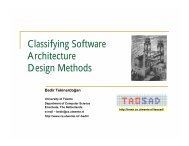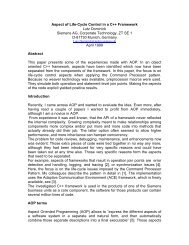Goals and Quality Characteristics: Separating ... - ResearchGate
Goals and Quality Characteristics: Separating ... - ResearchGate
Goals and Quality Characteristics: Separating ... - ResearchGate
Create successful ePaper yourself
Turn your PDF publications into a flip-book with our unique Google optimized e-Paper software.
<strong>Goals</strong> <strong>and</strong> <strong>Quality</strong> <strong>Characteristics</strong>: <strong>Separating</strong> Concerns ∗<br />
Elena Navarro<br />
Computer Science Department<br />
University of Castilla-La Mancha<br />
Avda. España S/N, Albacete, Spain<br />
enavarro@info-ab.uclm.es<br />
Abstract<br />
Software Requirements Specification (SRS) organization<br />
for complex <strong>and</strong>/or large systems have to do with several<br />
not faced challenges until the moment. This organization<br />
is a key factor to facilitate the quality assurance of the<br />
SRS, regarding features as: correctness, completeness,<br />
consistency <strong>and</strong> modifiability. Organization is also<br />
crucial for an effective exploitation of the SRS when<br />
elaborating other related or derived artefacts. Although<br />
there is a consensus about SRS content, this is not<br />
applicable to the organization. Nevertheless, it is evident<br />
that depending on the system, their stakeholders <strong>and</strong> the<br />
activities to perform with the SRS, the relevant criteria for<br />
SRS organization <strong>and</strong> presentation can be different.<br />
Additionally, another of the main problems to be solved is<br />
related to the crosscutting of requirements that produces<br />
tangled specifications. This work faces these issues: the<br />
organization of SRS by applying Aspect Oriented<br />
techniques to properly manage the crosscutting. A Goal<br />
Oriented approach for requirements allows us to<br />
establish traceability from software goals to specific<br />
requirements <strong>and</strong> from the latter to operationalizations<br />
that are realized as software components. In this work, we<br />
present an integration of aspect <strong>and</strong> Goal Oriented<br />
approaches, to properly manage the SRS organization<br />
<strong>and</strong> presentation. Furthermore, our proposal uses the<br />
st<strong>and</strong>ard ISO/IEC 9126 as the starting point to organize<br />
goals <strong>and</strong> requirements. ATRIUM, a methodology to<br />
concurrently define requirements <strong>and</strong> software<br />
architecture, provides the setting for our proposal.<br />
1. Introduction<br />
IEEE 830-1998 [11] recommendations are the<br />
milestone concerning the contents which are m<strong>and</strong>atory in<br />
a Software Requirements Specification (SRS). This<br />
st<strong>and</strong>ard suggests several possible organizations for<br />
specific software requirements. Nevertheless, when the<br />
amount of requirements <strong>and</strong>/or the complexity are<br />
considerable, those suggestions are not enough.<br />
Requirements organization <strong>and</strong> presentation are crucial to<br />
Patricio Letelier, Isidro Ramos<br />
Department of Information Systems <strong>and</strong> Computation<br />
Polytechnic University of Valencia<br />
Camino de Vera s/n, Valencia, Spain<br />
{letelier, iramos}@dsic.upv.es<br />
facilitate their maintenance <strong>and</strong> ensure other desirable<br />
features such as: correction, completeness, consistency<br />
<strong>and</strong> traceability. Along the requirements elicitation <strong>and</strong><br />
specification process, several stakeholders are involved<br />
(both from the customer <strong>and</strong> technical side) every one<br />
with their own interests <strong>and</strong> views of the system, which<br />
ought to be rightly represented <strong>and</strong> reconciled in the SRS.<br />
A requirement is a capacity that software should<br />
exhibit or a condition that should be met. This capacity or<br />
condition can be expressed at different abstraction or<br />
detail levels. Concretely, we distinguish two levels: goals<br />
<strong>and</strong> requirements. <strong>Goals</strong> allow one to establish, by means<br />
of refinement <strong>and</strong> composition processes, a derivation<br />
graph from software interests or goals until specific<br />
requirements. On the other h<strong>and</strong>, requirements are<br />
detailed enough as to be assigned to a software component<br />
<strong>and</strong> lately be verified. Goal Oriented Requirements<br />
Engineering [13] employs this strategy to perform this<br />
refinement from goals until requirements <strong>and</strong> their<br />
subsequent operationalization in software elements.<br />
In the literature, different paradigms cope with the<br />
separation of concerns of a system in order to provide<br />
support for evolution adaptability, comprehensibility, etc.<br />
These concerns can range from non-functional features, as<br />
security or fault tolerance, to functional features. Aspect<br />
Oriented Software Development (AOSD) [1] is one of<br />
these approaches. AOSD provides a set of techniques that<br />
allow managing those interests that appear scattered along<br />
the system <strong>and</strong> crosscut several elements. AOSD identifies<br />
these concerns realizing them as aspects <strong>and</strong> managing<br />
them explicitly.<br />
In the AOSD context, several proposals have been<br />
introduced at different abstraction levels, both during<br />
implementation [12] <strong>and</strong> design [21] that define an aspect<br />
as an additional constructor of the language. It is<br />
associated to the constructor “class” to manage the<br />
crosscutting that can appear in the methods specification<br />
for a class. Several works have also been proposed at the<br />
requirements level as Aspect Oriented Requirements<br />
Engineering (AORE) [20]. In this proposal, an aspect is a<br />
requirement which is related to a set of other<br />
requirements, but that is separately specified. By means of<br />
∗ This work has been funded by the Spanish CICYT project DYNAMICA TIC2003-07776-C02-02
a technique known as weaving, it manages this<br />
crosscutting.<br />
The aim of this work is to present our proposal to<br />
organize software requirements, by integrating Aspect<br />
Oriented techniques within a Goal Oriented approach for<br />
requirements, as we previously sketched in [17].<br />
Furthermore, the ISO/IEC 9126 [10] st<strong>and</strong>ard is used as a<br />
starting point to define the concerns. ATRIUM [16], a<br />
methodology to concurrently define requirements <strong>and</strong><br />
software architecture, provides the setting for our<br />
proposal.<br />
The reminder of this work is organized as follow.<br />
Section 2 briefly describes the ATRIUM methodology.<br />
Section 3 introduces the ISO/IEC 9126 st<strong>and</strong>ard <strong>and</strong> how<br />
it is used in our proposal. Section 4 presents in detail the<br />
set of tasks that drive the goals model definition. The way<br />
we apply the set of tasks to a case study is shown in<br />
section 5. Some related works are described in section 6.<br />
Eventually, the achieved conclusions <strong>and</strong> future works<br />
round up the work.<br />
2. ATRIUM: Requirements <strong>and</strong> Software<br />
Architectures<br />
ATRIUM is a methodology oriented to the concurrent<br />
definition of Software Architectures (SA) <strong>and</strong><br />
Requirements. In ATRIUM, decisions at architectural<br />
level are made to satisfy specific software requirements.<br />
With this aim, ATRIUM provides the analyst with<br />
guidance, along an iterative process, from an initial set of<br />
user/system needs until the instantiation of the<br />
architecture, specified by means of a PRISMA model<br />
[18]. PRISMA is an architecture description language that<br />
allows us to define dynamic architectures.<br />
User/System Needs<br />
Architectural<br />
Styles<br />
Interaction<br />
Patterns<br />
Derivation<br />
Rules<br />
Generation<br />
Patterns<br />
Define<br />
<strong>Goals</strong><br />
Define<br />
Scenarios<br />
Specify<br />
Collaborations<br />
Formalization<br />
Compilation<br />
<strong>Goals</strong><br />
Model<br />
Scenarios<br />
Model<br />
Proto-<br />
Architecture<br />
Formal<br />
Model<br />
Instanced<br />
PRISMA<br />
Model<br />
Figure 1 ATRIUM: Activities <strong>and</strong> Artifacts<br />
ATRIUM entails five activities (Figure 1) to be iterated<br />
on in order to define <strong>and</strong> refine the different artifacts <strong>and</strong><br />
allow the analyst to reason about partial views, both of<br />
requirements <strong>and</strong> of architecture. The Define Goal activity<br />
(see section 4) allows identifying the different concerns of<br />
the software <strong>and</strong> the crosscutting between them. These<br />
concerns are c<strong>and</strong>idate to be classified as aspects, in the<br />
Figure 0 Unfolding a Software Specification<br />
PRISMA specification, <strong>and</strong> realize them through aspects<br />
integrated into components <strong>and</strong>/or connectors.<br />
3. ISO/IEC 9126: Selecting <strong>and</strong> Identifying<br />
Concerns<br />
<strong>Quality</strong> criteria, used for the software products<br />
assessment, are highly related to the requirements<br />
specified in their SRS. This means a practical binding<br />
with the global organization of the SRS in order to<br />
facilitate the subsequent evaluation of the software<br />
quality. In this sense, the ISO/IEC 9126 st<strong>and</strong>ard is an<br />
important reference as software quality model by defining<br />
a set of features that can be required of quality software.<br />
This reason makes the ISO/IEC 9126 especially suitable<br />
as taxonomy for concerns. It provides an initial framework<br />
to elicit <strong>and</strong> organize goals <strong>and</strong> requirements. In this way,<br />
as the informal software needs are elicited, they can be<br />
analyzed, broken down <strong>and</strong> organized. This allows<br />
managing the specification crosscutting, by reducing or<br />
removing other drawbacks such as: redundancy,<br />
inconsistencies, etc. At the same time, weaving<br />
relationships can be defined in order to re-establish a<br />
tangled representation whenever it is needed.<br />
ISO/IEC 9126 determines three software quality<br />
aspects: process quality, product quality <strong>and</strong> product in<br />
use quality. The main aim is just the latter, i.e., to notice<br />
the product quality through the effect that its use causes.<br />
The quality in use depends on or is influenced by the<br />
internal <strong>and</strong> external characteristics of the software<br />
product. These characteristics are affected by the software<br />
construction process. With regard to the specific<br />
requirements, described in the SRS, we are interested in<br />
the characteristics defined for the software product quality<br />
<strong>and</strong> for the quality in use. These characteristics are listed<br />
in Table 1.<br />
We have to notice that from the software requirements<br />
perspective this taxonomy goes beyond the traditional<br />
classification of functional <strong>and</strong> non-functional<br />
requirements which is not a meaningful contribution to the<br />
requirements organization. In fact, most of the typical<br />
functional requirements can be set with the suitability subcharacteristic.<br />
On the other h<strong>and</strong>, the software product<br />
capacity to satisfy the st<strong>and</strong>ards, conventions or<br />
regulations are broken down as sub-characteristics of type
“compliance” below each quality software product subcharacteristic.<br />
Although the ISO/IEC 9126 provides us<br />
with a wide set of concerns, this set can be extended if<br />
needed. In this case, several alternatives arise when we<br />
apply our proposal:<br />
a) Considering a new dimension for organizing<br />
goals/requirements, additional to the taxonomy<br />
proposed by ISO/IEC 9126. This option could be of<br />
interest whenever the additional characteristics are as<br />
relevant as those already considered <strong>and</strong> whether the<br />
crosscutting with them could be high.<br />
b) Including a new characteristic/sub-characteristic for<br />
extending the taxonomy. This alternative would be<br />
recommended when the aspects which are dealt with<br />
are not as relevant as those considered <strong>and</strong>/or it is not<br />
expected that the crosscutting could be so high.<br />
c) Dealing with this element as an attribute of the<br />
goal/requirement. This option is suggested when it is<br />
coped with aspects which are not so relevant (they are<br />
neither exactly goals nor requirements) or do not<br />
involve an important crosscutting. However, they are<br />
particularly interesting to group <strong>and</strong> present<br />
goals/requirements.<br />
Table 1 <strong>Quality</strong> <strong>Characteristics</strong> of the ISO/IEC 9126<br />
<strong>Quality</strong> Type Characteristic Sub- Characteristic<br />
Software Product <strong>Quality</strong><br />
<strong>Quality</strong> in use<br />
functionality<br />
reliability<br />
usability<br />
efficiency<br />
maintainability<br />
portability<br />
effectiveness<br />
productivity<br />
safety<br />
satisfaction<br />
suitability<br />
accuracy<br />
interoperability<br />
security<br />
compliance<br />
maturity<br />
fault tolerance<br />
recoverability<br />
compliance<br />
underst<strong>and</strong>ability<br />
learneability<br />
operability<br />
attractiveness<br />
compliance<br />
time behaviour<br />
resourse utilisation<br />
compliance<br />
analysability<br />
changeability<br />
stability<br />
testeability<br />
compliance<br />
adaptability<br />
installability<br />
co-existence<br />
replaceability<br />
compliance<br />
The IEEE 830-1998 offers several criteria <strong>and</strong><br />
guidelines to organize specific requirements. It recognizes<br />
that there is no an optimum organization to be applicable<br />
to every system. Between the mentioned organization<br />
criteria are: operation system mode, user type, problem<br />
entities, system services, stimulus, answer <strong>and</strong>/or<br />
functions hierarchies. Therefore, as it is recommended by<br />
the c) alternative, those elements can be dealt as attributes<br />
of goals/requirements instead of extending the taxonomy.<br />
In this way, it is possible to offer a view related to the<br />
joins based on these elements, although they are not<br />
elements of the initial taxonomy.<br />
For instance, we could deal with the section “logic<br />
requirement of the database” (included in the IEEE 830-<br />
1998) as an aditional dimension (called data). Figure 2<br />
illustrates the framework extension with new dimensions.<br />
4. <strong>Goals</strong> Model <strong>and</strong> Concerns of the system<br />
Both identification <strong>and</strong> specification of the different<br />
concerns, <strong>and</strong> their possible crosscutting, are addressed,<br />
in this work, with the definition of the tasks described in<br />
Figure 3, which integrate the activity 1. The output of this<br />
activity is the <strong>Goals</strong> Model, which was previously<br />
described in [15]. Its conception was influenced by the<br />
NFR Framework [3] <strong>and</strong> the KAOS proposal [4], although<br />
it integrates both functional <strong>and</strong> non-functional<br />
requirements. Furthermore, it plays an important role for<br />
the aspect identification as we previously stated in [17].<br />
The <strong>Goals</strong> Model allows one to specify not only goals,<br />
requirements <strong>and</strong> operationalizations but also the<br />
crosscutting which can appear. For the <strong>Goals</strong> Model<br />
construction, the ISO/IEC 9126 quality model, described<br />
above, is used as an instantiable framework, providing the<br />
analyst with an initial description of the set of concerns of<br />
the system.<br />
4.1. Defining the <strong>Goals</strong> Model<br />
Figure 3 establishes the workflow for the <strong>Goals</strong> Model<br />
elaboration along with the input artifacts needed for its<br />
realization. Although Figure 3 shows only a sequential<br />
flow to apply the tasks, in practice, its application is<br />
iterative. Involved tasks, in the <strong>Goals</strong> Model, are run with<br />
every new identified or selected goal.<br />
The first task deals with the Identification/Selection of<br />
<strong>Goals</strong>. As we can observe in Figure 3 the st<strong>and</strong>ard<br />
ISO/IEC 9126 is an input for this task. This model<br />
provides an initial view of the concerns that could be<br />
meaningful for the system. In this way, the analyst can<br />
iteratively select what he/she considers proper <strong>and</strong> initiate<br />
its specification <strong>and</strong> refinement. As we elicit the<br />
requirements, it could be convenient to incorporate new<br />
concerns to properly include additional<br />
goals/requirements.
Figure 3 Workflow to specify goals <strong>and</strong> requirements<br />
User/System needs are other input for this task. They<br />
provide us with information to identify new<br />
goals/requirements. Every goal, established by means of<br />
this process, is aligned with the specification of concerns<br />
determined by the ISO/IEC 9126 model, <strong>and</strong> acts as a<br />
node for the graph definition. This will provide us with a<br />
twofold advantage; on one h<strong>and</strong> to facilitate the<br />
underst<strong>and</strong>ing of the specification, <strong>and</strong>, on the other h<strong>and</strong>,<br />
to drive the elicitation <strong>and</strong> analysis process.<br />
In the task Specify Goal, the attributes, that constitute<br />
it, are not only established, such as its name, priority, etc.,<br />
but also composition relationships (AND/OR/XOR)<br />
among goals ([15] offers a full description of the goals<br />
model).<br />
When crosscutting of goals/requirements is identified,<br />
task Specify Weaving is performed in order to establish<br />
weaving relationships. These relationships can be<br />
stereotyped according to the traditional AOSD weaving<br />
mechanisms, i.e., before <strong>and</strong> after. This allows us to<br />
express how a piece of goal/requirement specification<br />
(from the aspect point of view) is incorporated inside<br />
some goal/requirement specification. Other more specific<br />
weaving relationships could be used (like in [19]), but we<br />
suggest to do this refinement in the specific domain<br />
context of the system.<br />
This refinement process of goals goes on until the goal<br />
is assignable to a system agent. At this moment, we<br />
change from an intentional refinement to an operational<br />
refinement, <strong>and</strong> consequently to the specification of a<br />
requirement. Another difference between a goal <strong>and</strong> a<br />
requirement stems from the latter ones have to be<br />
verifiable. In this way, Identify/Specify Requirements<br />
follows a similar process to that observed for goals,<br />
through the definition of attributes <strong>and</strong> composition<br />
relationships. Additionally, weaving relationships can also<br />
be established.<br />
After the requirement specification, the next task is<br />
Specify Operationalization, that is, the definition of the<br />
agent or set of agents that collaborate in its realization.<br />
During the <strong>Goals</strong> Model construction, the<br />
operationalization is only a description of the proposed<br />
solution for the realization of a requirement, working this<br />
description as an input for the ATRIUM activity Define<br />
Scenarios. The latter cope with the whole definition of the<br />
solution through the relevant scenario specification. It is<br />
introduced in the <strong>Goals</strong> Model in order to allow us to<br />
describe the relationships between that solution <strong>and</strong> the<br />
already defined requirements in the Model. In this way,<br />
we can denote how a solution can contribute to positively<br />
realize a requirement <strong>and</strong> negatively to others. Thanks to<br />
these relationships, we achieve a more exhaustive analysis<br />
of the set of possible solutions.<br />
5. Case Study<br />
This section illustrates how we have applied our<br />
proposal in the context of a real system. This work was<br />
developed thanks to the collaboration with a group<br />
involved in the European Project Environmental Friendly<br />
<strong>and</strong> cost-effective Technology for Coating Removal<br />
(EFTCoR) [5]. The main scenario of this project is the<br />
hull maintenance operations. Mainly, it addresses<br />
operations of coating removal, washing <strong>and</strong> re-painting of<br />
hull of ships by using a family of robots, that either<br />
performs different operations or the same operation but in<br />
a different way.<br />
These maintenance operations have a high impact both<br />
economical <strong>and</strong> environmental. The former is related to<br />
the time that the ship must go into the dry dock <strong>and</strong> to the<br />
costs derived of its maintenance. The later is due to the<br />
generated residues along the operations. Furthermore,<br />
these processes are very hazardous for operators.<br />
Figure 4 Teleoperation Robotic System for Hull<br />
Maintenance Operations
Portabilit<br />
Replaceability Adaptability<br />
appears on Table 2 (more details about the applicable<br />
attributes can be found in [15])<br />
The graph on Figure 4 shows (part of) the <strong>Goals</strong> Model<br />
where the refinement of goals from Table 2 is reviewed.<br />
In this way, we observe how Portability, Functionality<br />
<strong>and</strong> Efficiency are some of the selected characteristics to<br />
become concerns for the EFTCoR system. Furthermore,<br />
this figure shows us some of the relationships of<br />
refinement that were established. For instance, the AND<br />
relationship for the goals AdaptabilityWorking-<br />
Environment <strong>and</strong> AdaptabilityHullMaintenaceOperation<br />
that was introduced to satisfy Adaptability. On the other<br />
h<strong>and</strong>, a weaving relationship has been established between<br />
AdaptabilityWorkingEnvironment <strong>and</strong> Control-<br />
Possitioning.<br />
Table 2 (Partial) Description of <strong>Goals</strong> for EFTCoR<br />
GOAL DESCRIPTION<br />
Functionality The system has to provide functions<br />
which meet stated <strong>and</strong> implied needs<br />
Suitability The system has to provide an<br />
appropriate set of functions for<br />
specified tasks <strong>and</strong> user objectives<br />
CoordinateDevices The RDCU has to coordinate robotic<br />
devices according to the current<br />
mission procedure <strong>and</strong> global system<br />
state<br />
ControlPossitioning The RDCU has to control the<br />
positioning devices<br />
ControlTools The RDCU has to control the tools<br />
attached to positioning devices<br />
(blasting head, painting tool, etc)<br />
Efficiency The system should use efficiently their<br />
resources<br />
TimeBehaviour The system should respond with<br />
appropriate speed<br />
PerformanceOperation The system should respond with<br />
appropriate speed to the operation<br />
comm<strong>and</strong>s<br />
Portability The system should be able to be<br />
transferred from one environment to<br />
another<br />
Replaceability The system should be able to use<br />
different software product for the<br />
same purpose<br />
Adaptability The systems has to be adaptable for<br />
different specified environments<br />
AdaptabilityWorkingEnvironments The system operation has to be<br />
adaptable to different working<br />
environments<br />
AdaptabilityHullMaintenanceOperation The system operation has to be<br />
adaptable to different hull<br />
maintenance operations<br />
6. Related works<br />
There are many works related to the management of<br />
aspects at different abstraction levels, at implementation<br />
as well as design level. At the requirements level, several<br />
proposals have focused on how to identify <strong>and</strong> specify<br />
concerns of the system. They also focus on how to<br />
determine which concerns will be realized as aspect, in<br />
other derived artifacts, in such a way that the closure<br />
property [6] is satisfied.<br />
Grundy [9] has defined a proposal called Aspect-<br />
Oriented Component Engineering (AOCE), in order to<br />
define <strong>and</strong> develop software components from<br />
requirements until design, implementation <strong>and</strong><br />
deployment. In this proposal, components are integrated<br />
by aspects, but there is no explicit specification about how<br />
these aspects are a realization of the aspects at the<br />
requirements level.<br />
Rashid et al [20] have proposed a model for<br />
requirements engineering that identifies the concerns at an<br />
early stage of development, along with the requirements.<br />
This model allows relating <strong>and</strong> establishing the impact of<br />
these early aspects on later stages of the development.<br />
Nevertheless, this proposal does not allow recreate the<br />
specification to offer a better comprehension for the<br />
validation end user.<br />
Brito et al [2] proposal is the closest one to our<br />
approach. It introduces a goals model, the NFR<br />
Framework [3] concretely, to specify non-functional<br />
requirements along with another technique, such as use<br />
cases or viewpoints, to specify functional requirements. In<br />
this way it extends the framework with a new type of<br />
relationship called required concerns in order to<br />
determine a potential crosscutting with other<br />
requirements. However, our proposal provides the analyst<br />
with a unique artefact to specify both kinds of<br />
requirements. It facilitates both its use <strong>and</strong><br />
comprehensibility.<br />
On the other h<strong>and</strong>, no stated proposals provide the<br />
analyst with an initial framework which helps him/her to<br />
identify the concerns of the system. Finally, another<br />
significant difference is related to the uniform<br />
management of goals/requirements, with regard to the<br />
applicable categories for its classification. Nevertheless,<br />
other proposals explicitly focus on the distinction between<br />
functional <strong>and</strong> non-functional, by employing different<br />
techniques to describe both kinds of goals/requirements.<br />
This entails a high cost in terms of legibility <strong>and</strong><br />
maintainability.<br />
Additionally, most of the Aspect Oriented requirements<br />
proposals, such as [19, 14], apply separation of concerns<br />
techniques after identifying the crosscutting in the<br />
specification. In this way, they offer a solution to improve<br />
the original specification. In our proposal, thanks to the<br />
use of a Goal Oriented approach, that allows us to begin<br />
the software requirement specification at a level of<br />
concerns, we can deal with the goals <strong>and</strong> requirements<br />
relationships detecting <strong>and</strong> managing the crosscutting<br />
among them by using weaving relationships.<br />
7. Conclusions <strong>and</strong> future works<br />
In this work, we have presented a proposal to elicit <strong>and</strong><br />
analyse requirements that integrates Goal Oriented <strong>and</strong><br />
Aspects Oriented approaches. Owing to the Goal Oriented<br />
approach, an explicit traceability is preserved from goals<br />
towards requirements, <strong>and</strong> from the latter to the<br />
operationalizations that realize the software components.<br />
On the other h<strong>and</strong>, the Aspect Oriented approach allows a
smart <strong>and</strong> effective management of the crosscutting that<br />
can appear in the SRS when goals <strong>and</strong> requirements are<br />
tangled. By defining weaving relationships between<br />
goals/requirements elements an optimal representation is<br />
achieved, that can allow to recreate the original<br />
representation whether it is needed. A workflow has been<br />
defined that integrates both approaches, detailing a set of<br />
tasks. It provides a guide for the elaboration <strong>and</strong><br />
organization of the requirements.<br />
Another advantage that offers our proposal is the use of<br />
the ISO/IEC 9126 as a starting point to establish the<br />
possible concerns. Additionally, it is possible to tailor, in<br />
terms of content, the SRS to the IEEE 830-1998 but with<br />
meaningful advantages for elaboration <strong>and</strong> organization of<br />
the requirement specification.<br />
Several challenges are to be faced. One of them is<br />
related to the development of a tool that provides our<br />
proposal with a proper support. The flexibility for the<br />
requirements representation, regarding several criteria, is<br />
one of main factor in this development. With this aim, we<br />
are exploiting the structure of characteristics as well as<br />
using attributes which are defined for goals <strong>and</strong><br />
requirements.<br />
Another point of interest, for future works, is related to<br />
the weaving relationships. Concretely, we are concerned<br />
with its suitability to the set of offered relationships along<br />
with their semantic. According to this topic, the emerging<br />
issues from the case study will facilitate its verification<br />
<strong>and</strong> validation. Specially when, following the ATRIUM<br />
stated process, the established weaving relationships <strong>and</strong><br />
the identified concerns <strong>and</strong> requirements will have<br />
traceability to aspects in architectural artefacts.<br />
References<br />
[1] Aspect-Oriented Software Development,<br />
http://www.aosd.net<br />
[2] I. Brito, A. Moreira, “Integrating the NFR framework in a<br />
RE model”, Early Aspects 2004: Aspect-Oriented Requirements<br />
Engineering <strong>and</strong> Architecture Design Workshop, March 22,<br />
2004 - Lancaster, UK in conjunction with 3rd Aspect-Oriented<br />
Software Development Conference.<br />
[3] L. Chung, B. A. Nixon, E. Yu <strong>and</strong> J. Mylopoulos, Non-<br />
Functional Requirements in Software Engineering, Kluwer<br />
Academic Publishing, 2000.<br />
[4] A. Dardenne, A. van Lamsweerde, <strong>and</strong> S. Fickas: “Goaldirected<br />
Requirements Acquisition”. Science of Computer<br />
Programming, 20:3-50, 1993.<br />
[5] EFTCOR: Environmental Friendly <strong>and</strong> cost-effective<br />
Technology for Coating Removal. European Project within the<br />
5th Framework Program (GROWTH G3RD-CT-00794), 2003.<br />
[6] T. Elrad, M. Aksits, G. Kiczales, K. Lieberherr, H. Ossher,<br />
“Discussing aspects of AOP”, Communications of the ACM,<br />
Vol. 44 , Issue 10, pp. 29 – 32, October, 2001.<br />
[7] T. Elrad, R. E. Filman <strong>and</strong> A. Bader, “Aspect-oriented<br />
programming: Introduction”, Communications of the ACM,<br />
Vol. 44 , Issue 10, pp. 29 – 32, October, 2001.<br />
[8] C. Fernández, J.A. Pastor, P. Sánchez, B. Álvarez, A.<br />
Iborra: “Co-operative Robots for Hull Blasting in European<br />
Shiprepair Industry. Robotics <strong>and</strong> Automation Magazine<br />
(RAM)”, special issue on Industrial Robotics Applications &<br />
Industry-Academia Cooperation in Europe. New Trends <strong>and</strong><br />
Perspectives. (To appear in September 2004)<br />
[9] J. Grundy, “Aspect-Oriented Requirements Engineering for<br />
Component-Based Software Systems”, In Proceedings of the<br />
IEEE International Symposium on Requirements Engineering,<br />
June 07 - 11, 1999, Limerick, Irel<strong>and</strong>.<br />
[10] ISO/IEC St<strong>and</strong>ard 9126-1 Software Engineering- Product<br />
<strong>Quality</strong>-Part1: <strong>Quality</strong> Model, ISO Copyright Office, Geneva,<br />
June 2001<br />
[11] IEEE Std 830-1998. IEEE Recommended Practice for<br />
Software Requirements Specifications, In Volume 4: Resource<br />
<strong>and</strong> Technique St<strong>and</strong>ards, The Institute of Electrical <strong>and</strong><br />
Electronics Engineers, Inc. IEEE Software Engineering<br />
St<strong>and</strong>ards Collection.<br />
[12] G. Kiczales, J. Lamping, A. Mendhekar, C. Maeda, C.<br />
Lopes, J. M. Loingtier <strong>and</strong> J. Irwin, “Aspect-Oriented<br />
Programming”. In the Proceedings of the European Conference<br />
on Object-Oriented Programming, Finl<strong>and</strong>. Springer-Verlag<br />
LNCS 1241. pp. 220-242, June 1997.<br />
[13] A. van Lamsweerde “Goal-Oriented Requirements<br />
Engineering: A Guided Tour”, Invited Paper for 5th IEEE<br />
International Symposium on Requirements Engineering,<br />
Toronto, August, 2001, pp. 249-263.<br />
[14] A. M. D. Moreira, J Araújo, I. Sofia Brito, “Crosscutting<br />
quality attributes for requirements engineering”. In Proceedings<br />
of the 14th international conference on Software Engineering<br />
<strong>and</strong> Knowledge Engineering, pp. 167-174, July 15-19, 2002,<br />
Ischia, Italy.<br />
[15] E. Navarro, I. Ramos <strong>and</strong> J. Pérez: “<strong>Goals</strong> Model-Driving<br />
Software Architecture”, 2nd International Conference on<br />
Software Engineering Research, Management <strong>and</strong> Applications,<br />
May 5-8, 2004, Los Angeles, CA, USA.<br />
[16] E. Navarro, I. Ramos <strong>and</strong> J. Pérez: “Software Requirements<br />
for Architectured Systems”. Proc. 11th IEEE International<br />
Conference on Requirements Engineering, pp. 365-366,<br />
September 8-12, 2003, Monterey, CA, USA.<br />
[17] E. Navarro <strong>and</strong> I. Ramos, "Requirements <strong>and</strong> Architecture:<br />
a marriage for <strong>Quality</strong> Assurance", VIII Jornadas de Ingeniería<br />
del Software y Bases de Datos, Alicante, 12-14 Noviembre 2003<br />
[18] J. Pérez, I. Ramos, J. Jaén, P. Letelier <strong>and</strong> E. Navarro,<br />
“PRISMA: Towards <strong>Quality</strong>, Aspect Oriented <strong>and</strong> Dynamic<br />
Software Architectures”, In Proceedings of the 3rd IEEE<br />
International Conference on <strong>Quality</strong> Software, Dallas, Texas,<br />
USA, pp. 59-66, November 6 - 7, 2003.<br />
[19] A. Rashid, A. Moreira, J. Araújo, “Modularisation <strong>and</strong><br />
composition of aspectual requirements”, In the Proceedings of<br />
the 2nd international conference on Aspect-oriented software<br />
development, pp. 11-20, March 17 - 21, 2003, Boston,<br />
Massachusetts.<br />
[20] A. Rashid, P. Sawer, A. Moreira <strong>and</strong> J. Araújo, “Early<br />
Aspects: a Model for Aspect-Oriented Requirements<br />
Engineering”, In the Proceedings of the International<br />
Conference on Requirements Engineering, pp. 199-202,<br />
September 9-13, 2002, Essen, Germany.<br />
[21] J. Suzuki <strong>and</strong> Y. Yamamoto, “Extending UML with<br />
Aspects: Aspect Support in the Design Phase”, AOP Workshop<br />
at ECOOP’99, Lisbon, Portugal, 1999.


